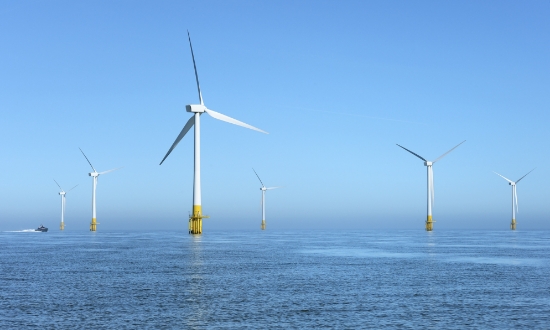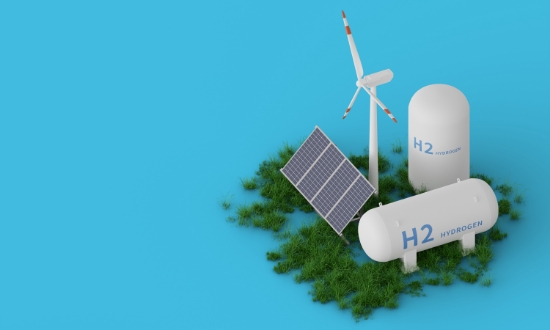- Home
- Industries
- Renewable Energy Industry
Renewable Energy Industry

Facilitation of Energy Supply
through Catch-up Technological Innovation
South Korea has set a goal of achieving carbon neutrality by 2050 and is actively implementing policies to accelerate the energy transition. According to the World Energy Investment 2024 report published by the International Energy Agency (IEA), South Korea's average annual clean energy investment increased by approximately 10% from 2021 to 2023 compared to the 2016-2020 average.
Renewable Energy Targets for 2030Under the draft of the 11th Basic Plan for Long-term Electricity Supply and Demand (11th Basic Plan), which is expected to be finalized in early 2025, the Ministry of Trade, Industry and Energy (MOTIE) has set a target for renewable energy to account for 21.6% of South Korea’s energy mix by 2030, with an installed wind power capacity of 18.3 GW. Additionally, in August 2024, the government introduced an offshore wind offtake target of up to 7-8 GW per year by 2026 as part of a roadmap designed to enhance investor confidence.
Global Renewable Energy Companies
Expanding into South Korea
-
Global Renewable Energy Companies Expanding into South Korea
An increasing number of global renewable energy companies particularly in the wind and solar power sectors, are choosing to invest in South Korea. In the offshore wind sector, leading international firms have frequently announced plans to develop both fixed-bottom and floating wind farms, reinforcing South Korea's position as a key destination for renewable energy investment.
-
Establishment of Industrial
Ecosystem
Differentiated by RegionRegions with a new and renewable energy industry base or planned large-scale projects are working to strengthen the foundation for building an industrial ecosystem that is differentiated for each region. Local governments will play a leading role in discovering and promoting customized, large-scale projects for their regions, and the central government will support the establishment of infrastructure, R&D demonstration, and human resource development.
Investment Success Stories

Company E

Company E is a Norwegian state-owned integrated energy company with an annual revenue of USD 107 billion. It is one of the world's leading players in floating offshore wind power, operating approximately 50% of the total global floating offshore wind capacity. The Norwegian government is the largest shareholder, holding a 67% stake in the company. In South Korea, Company E is developing the Bandibuli floating offshore wind farm, located 60~70 km off the coast of Ulsan in waters 150-300 meters deep. The project will have a total generation capacity of 750 MW, and upon completion, it is expected to supply electricity to approximately 440,000 households annually while reducing carbon dioxide emissions by an estimated 3.75 million tons. Company E is collaborating with major Korean firms, including Samsung Heavy Industries, POSCO E&C, and Doosan Enerbility, to advance the project.

Company C

With approximately KRW 40 trillion in assets under management, Company C is a global leader in renewable energy investments. It currently operates 11 renewable energy funds, covering wind, solar, and bioenergy projects. Company C is actively developing both floating and fixed-bottom offshore wind farms in Ulsan and Sinan, Jeollanam-do. In collaboration with SK E&S, the company has launched the first phase of the Jeonnam offshore wind project as a 50:50 joint venture. The project is scheduled to commence commercial operations in 2025.

Ryeongseon Son
Key Industries Promotion TeamRecommendation on Locations

Industrial Complex Information
Bit-Green Industrial Complex
| Initial designation date | 2009.09.30 |
|---|---|
| Designated area(m2) | 4,070,692 |
| Management | Korea Industrial Complex Corporation |
| Nearby Railway | Hampyeong Station |
| Distance from station(km) | 30 |
| Nearby Airport | Gwangju Airport |
| Distance from airport(km) | 20 |
| Industrial waterSupply capacity(ton/day) | 17130(㎥/day) |
| Affiliation local government | Gwangju Metropolitan City Gwangsan-gu, Jeollanam-do Hampyeong County |
| Population | 1,454,154 |

Industrial Complex Information
Saemangeum District National Industrial Complex
| Initial designation date | 2019.08.02 |
|---|---|
| Designated area(m2) | 18,495,346 |
| Management | Saemangeum Development Agency |
| Nearby Railway | Gunsan Station |
| Distance from station(km) | 28 |
| Nearby Airport | Gunsan Airport |
| Distance from airport(km) | 15 |
| Industrial water Supply capacity(ton/day) | 123077(㎥/day) |
| Affiliation local government | Jeollabuk-do Gunsan City |
| Population | 267,982 |

Industrial Complex Information
Ulsan Techno General Industrial Complex(Ulsan Free Economic Zone)
| Initial designation date | 2013.06.20 |
|---|---|
| Designated area(m2) | 1,286,977 |
| Management | Ulsan Metropolitan City |
| Nearby Railway | Taehwagang Station |
| Distance from station(km) | 9 |
| Nearby Airport | Ulsan Airport |
| Distance from airport(km) | 15 |
| Industrial water Supply capacity(ton/day) | 2614(㎥/day) |
| Affiliation local government | Ulsan Metropolitan City Nam-gu |
| Population | 1,140,310 |

Industrial Complex Information
Chunhwa Agricultural Industrial Complex
| Initial designation date | 2008.07.02 |
|---|---|
| Designated area(m2) | 211,785 |
| Management | Gyeongsangnam-do Miryang City |
| Nearby Railway | Sangdong Station |
| Distance from station(km) | 14 |
| Nearby Airport | Gimhae International Airport |
| Distance from airport(km) | 56 |
| Industrial water Supply capacity(ton/day) | 633(㎥/day) |
| Affiliation local government | Gyeongsangnam-do Miryang City |
| Population | 105,099 |

Industrial Complex Information
Namdong National Industrial Complex (Renewable Business District)
| Initial designation date | 1980.09.02 |
|---|---|
| Designated area(m2) | 9,504,046 |
| Management | Korea Industrial Complex Corporation |
| Nearby Railway | Bupyeong Station |
| Distance from station(km) | 9 |
| Nearby Airport | Incheon Airport |
| Distance from airport(km) | 32 |
| Industrial water Supply capacity(ton/day) | 49081(㎥/day) |
| Affiliation local government | Incheon Metropolitan City Namdong-gu |
| Population | 2,943,491 |

Industrial Complex Information
Haso Eco-friendly General Industrial Complex
| Initial designation date | 2012.05.11 |
|---|---|
| Designated area(m2) | 306,703 |
| Management | Daejeon Metropolitan City |
| Nearby Railway | Daejeon Station |
| Distance from station(km) | 17 |
| Nearby Airport | Cheongju International Airport |
| Distance from airport(km) | 71 |
| Industrial water Supply capacity(ton/day) | 1300(㎥/day) |
| Affiliation local government | Daejeon Metropolitan City Dong-gu |
| Population | 1,469,431 |











 +82-2-3460-7723
+82-2-3460-7723
 sls@kotra.or.kr
sls@kotra.or.kr